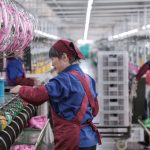 China’s colossal growth of textile and clothing industry has contributed to the rampant pollution prevailing today. The wastewater emissions from dyeing and printing in China are estimated about 3 × 106 to 4 × 106 m3 per day, i.e. 3 – 5 tons wastewater a day from dyeing 100 m fabric. The wastewater is characterized by intense color, high pollutant concentrations and poor biological degradability. It contains large amounts of harmful substances like formaldehyde and chemical auxiliaries that could cause headache, skin allergies and other health hazards. Some aromatic amines, heavy metals and preservatives are found to be “possibly carcinogenic” to humans, and they can destroy the equilibrium of ecosystem and also the aquatic life. The exhaust gases lead to serious harm to the atmospheric environment.
China’s colossal growth of textile and clothing industry has contributed to the rampant pollution prevailing today. The wastewater emissions from dyeing and printing in China are estimated about 3 × 106 to 4 × 106 m3 per day, i.e. 3 – 5 tons wastewater a day from dyeing 100 m fabric. The wastewater is characterized by intense color, high pollutant concentrations and poor biological degradability. It contains large amounts of harmful substances like formaldehyde and chemical auxiliaries that could cause headache, skin allergies and other health hazards. Some aromatic amines, heavy metals and preservatives are found to be “possibly carcinogenic” to humans, and they can destroy the equilibrium of ecosystem and also the aquatic life. The exhaust gases lead to serious harm to the atmospheric environment.
Today’s fashion is dirty & thirsty. China has initiated new stringent policies to protect the environment calling it a ‘fight for the future of fashion.’ China’s ‘Water Ten Plan’ is a sort of ‘declaration of war’ by the regulatory authorities against polluters. It’s an ultimatum for the industry including manufacturers and brands. Advanced benchmark has been set for the energy consumption and sewage standards. The production units are not allowed to go for any backward production capacity. The enhanced environmental protection requirements envisage closed collection system for waste gas. So, if there is any bad smell, then the entire production line or workshop plant will be ordered to close down. Water Ten requires mandatory equipment upgrade and achieve green benchmarking standards to improve environmental compliance. At present, nearly 75% of textile wastewater is not recycled. By 2020, textile enterprises would have “no water pollution tank.” by ensuring complete recycling of waste water and it’s reuse in the plant itself with the help of most modern technology.
Water Use Permits to manage the total water use and Wastewater discharge permits to control the total amount of wastewater discharge have been introduced. These permits act as both carrot and stick. They can be traded freely. Also, wastewater discharge permits are accepted as security for loans. A textile company has to pay an actual discharge fee of RMB 1.4/kg of COD to get it’s allotted permit but when it exceeds it’s quota then the purchase price from the open market is around 200 times the actual fee. This controls the use & discharge both and incentivizes those who pollute less for their efficiency.
China has not included textiles in the 10 key industries listed for transformation under it’s ‘Made in China 2025’ plan may be due to textiles’ decreasing economic importance and high environmental costs. But the government is keen to develop industries in the sectors like ‘New Materials’ that can help provide technical solutions for textiles. Textiles has been put on another list of 10 industries, the Circular Economy Ten to ensure zero discharge and reuse of most resources.
China’s revised law has provision for unlimited daily fines, shut down & criminal punishments (people sent to prison/detained). The new environmental law “Ten Plans” means China now has a strong & modern legal framework.
G.D. JASUJA
Managing Editor





